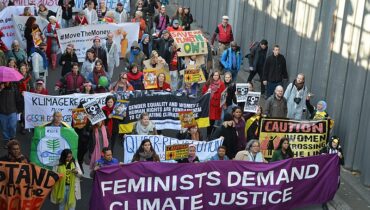The US and the world are confronted by the urgency of the climate crisis and its exacerbation of state fragility and gender inequality. The upcoming Leaders Summit on Climate and road to COP26 present a critical window of opportunity for the Biden administration to fully account for these overlapping challenges. US policymakers must harmonize their efforts to buffer the uneven impacts of climate-conflict risks and leverage the contributions of women to accelerate gains across climate action, gender equality, and peace and security.
Renewed US leadership on climate change and gender equality
To mark Earth Day, the Biden administration will host a Leaders Summit on Climate, which will convene 40 leaders from major global economies in an effort to raise ambition for climate action in the lead up to the United Nations Framework Convention on Climate Change (UNFCCC) conference (COP26) in November 2021. The Summit is part of wider efforts to course-correct US leadership on climate change and demonstrate new commitments to addressing the climate crisis, both at home and abroad.
To reassert US climate leadership and catalyze global action, Secretary John Kerry has been appointed as the Special Presidential Envoy for Climate and tasked with centering climate change in national security and foreign policy. President Biden has also issued an executive order that directs all relevant US agencies to develop strategies for integrating climate considerations into international work and calls on the Director of National Intelligence to factor the security implications of climate change into initiatives. These efforts signal the administration is taking the climate crisis seriously, including how conflict dynamics and instability can be exacerbated by climate change.
Critically, however, US climate action thus far fails to integrate a gender lens into these efforts. Although the administration has made parallel commitments to center gender equality – launching a new White House Gender Policy Council tasked with integrating women’s interests across domestic, economic and foreign policy – these have yet to intersect with the US climate agenda. Harmonizing these two agendas will be crucial to effective climate action that addresses the threat to peace and security posed by the climate crisis.
A Window of Opportunity for US Action
Together these policy commitments present a valuable window of opportunity to bring together re-energized climate and gender initiatives. To do so effectively requires an integrated approach. In peace and security work, gender is well-established as a cross-cutting issue, but these efforts often fail to account for the threat multiplier of climate change. Similarly, those working to address the climate crisis have not fully appreciated how the gendered implications of conflict and peacebuilding map onto their agendas.
Critically, women are on the frontlines of addressing climate change because of the central role they play in gathering water, energy, and food supplies. Their proximity to and dependence on natural resources disproportionately exposes women to climate-exacerbated threats. Climate change multiplies risks for women, especially those already living in fragile settings where climate impacts can inflame conflict. GIWPS research shows that the same structural inequalities that make women more vulnerable to climate-conflict risks also exclude them from meaningfully participating in the solutions, especially women from marginalized economic, social, and ethnic groups. An intersectional approach to addressing these underlying barriers can further US efforts to advance gender equality, while simultaneously meeting the environmental and fragility challenges posed by the climate crisis.
The good news is that there are several policy frameworks and spheres of influence already in place that can be leveraged to promote gender-responsive climate action that furthers peace and security. For example, the US Women, Peace and Security Act, US Global Fragility Act, and migration policy are promising entry points to integrate a gender-climate-fragility lens, as well as US leadership within NATO, the United Nations Security Council (UNSC), and the UNFCCC.
Below we identify five key areas of action for the US to accelerate gains across climate change, gender equality, and peace and security.
Leverage US Leadership in International Security
Global security institutions are beginning to recognize the impact of climate change in exacerbating the underlying conditions for conflict, particularly in fragile contexts. As the Biden administration works to rebuild international cooperation, the administration can reinvigorate global security partnerships by addressing climate consequences.
- NATO Secretary General Stoltenberg has advocated for the alliance to address the security implications of climate change. As these efforts progress, the US should press for the inclusion of gender-based conflict metrics in emerging NATO climate actions, including risk assessments and “climate-proofing” NATO operations.
- For over a decade, Member Parties have pressed the UN Security Council to recognize the emerging threat of climate change, however disagreements over the appropriate mission of the UNSC have stalled efforts. As the US considers supporting the widening of the Security Council mandate, this is an opportunity to integrate the climate-gender-conflict nexus within early warning assessments, mission reports, and mediation processes.
Mainstream Climate Into Women, Peace and Security
While the Women, Peace and Security Agenda (WPS) has achieved notable progress in mainstreaming a gender perspective into the field of peace and security, the link between climate change and security is underdeveloped. Climate was not mentioned in the WPS Agenda until the eighth resolution, UNSCR 2242 (2015). Currently, only about 1 in 4 WPS National Action Plans make direct reference to climate.
- WPS Act Implementation Strategies, and WPS National Action Plans more broadly, are key entry points for US agencies to integrate climate security into WPS work. The Secretary’s Office of Global Women’s Issues (S/GWI) and others focused on WPS can push for the integration of climate into WPS efforts.
- The US should create opportunities for women in climate and conflict-affected settings to inform the development of climate-responsive WPS interventions.
Develop Forward-Looking Global Fragility Act Implementation Strategies
The 2019 Global Fragility Act (GFA) marked a significant shift in US global security strategy, moving from a reactive approach to an integrated whole-of-government approach that aims to prevent conflict and promote stability. The GFA dedicates new resources in five high-priority, fragile countries over a sustained 10-year period and requires the US government to align diplomatic, development, and defense efforts.
- The US should consider fragile countries that are particularly vulnerable to climate change when making country selections, as risks will likely accelerate as the climate crisis worsens. Implementation strategies within countries should be both climate and gender-responsive and should be informed by participatory approaches and consultations with women-led civil society organizations.
Advocate for Gender-Responsive International Climate Action
Women activists, supportive Parties, and the UN Framework Convention on Climate Change (UNFCCC) secretariat are working to integrate gender considerations into the implementation of the Paris Agreement through the Lima Work Programme and corresponding Gender Action Plan (GAP). However, security considerations are not substantively integrated into the workplan, and there is no formal accountability mechanism.
- While the US has been supportive of the Gender Action Plan, the US could further push for elevating gender within the UNFCCC process. Linking gender-responsive climate action with climate security and building the technical capacity of developing countries to mainstream the gender-climate-conflict nexus within national actions could accelerate progress.
- Further, US strategies to meet targets outlined in the new National Determined Contribution should fully integrate gender considerations, which will not only strengthen the effectiveness of US efforts, but also signal to the world that the US will empower women to address the climate crisis. The US should follow the growing number of other Parties which have developed comprehensive gender strategies to reach their Paris Agreement targets.
Investigate and Address the Root Causes of Climate-Induced Displacement
Climate-induced migration and forced displacement are already occurring and will increase, with some estimates anticipating 250 million climate-displaced people by 2050. In places like the Dry Corridor of Central America, women and girls bear the brunt of climate displacement.
- The administration signaled its attention to this issue with its executive order for a study on the linkages between climate change and migration and how the US can best build climate resilience in vulnerable areas. A gender analysis should be central to this study to capture the gendered aspects of climate migration, such as increased labor burdens, gender-based violence, and loss of educational opportunities, to ensure effective action.
- This study should then inform and galvanize efforts to address the complex structural causes of climate-induced migration in a way that is inclusive of women and girls. For example, the promotion of climate-resistant livelihoods and sustainable agriculture can build socioeconomic resilience to climate shocks. Investing in stemming the root causes of forced displacement should be prioritized in US foreign policy and national security
There is an urgent need to bridge silos between work addressing climate change, gender equality, and security. Existing policy tools and institutions are promising entry points to synergize efforts to achieve a more peaceful and equitable future for all.
This article was adapted from a briefing the authors delivered to US State Department officials in April 2021.


